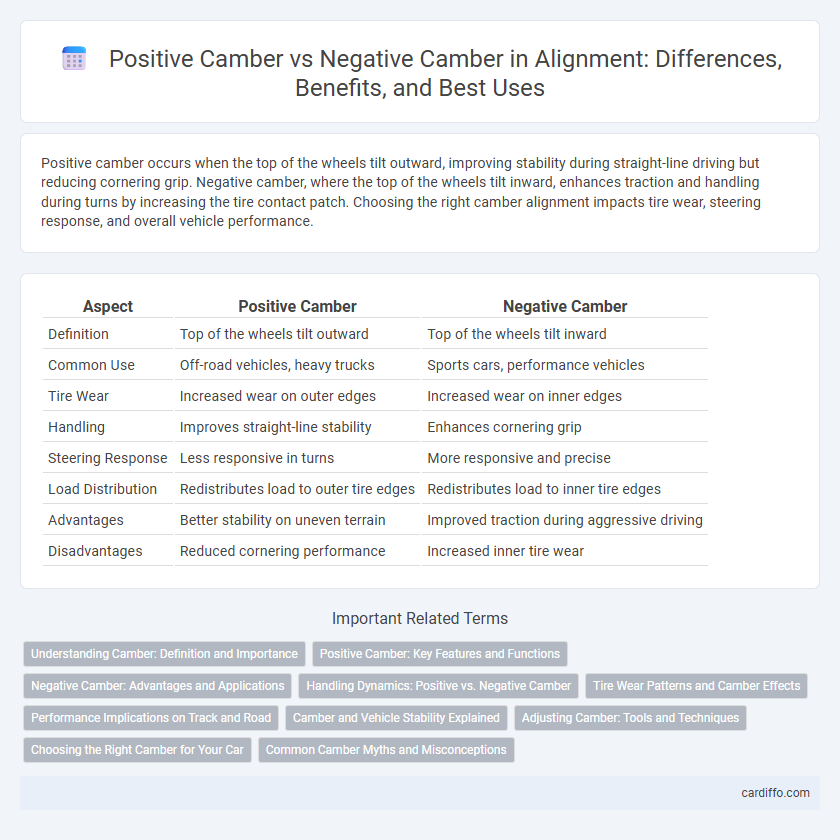Positive camber occurs when the top of the wheels tilt outward, improving stability during straight-line driving but reducing cornering grip. Negative camber, where the top of the wheels tilt inward, enhances traction and handling during turns by increasing the tire contact patch. Choosing the right camber alignment impacts tire wear, steering response, and overall vehicle performance.
Table of Comparison
| Aspect | Positive Camber | Negative Camber |
|---|---|---|
| Definition | Top of the wheels tilt outward | Top of the wheels tilt inward |
| Common Use | Off-road vehicles, heavy trucks | Sports cars, performance vehicles |
| Tire Wear | Increased wear on outer edges | Increased wear on inner edges |
| Handling | Improves straight-line stability | Enhances cornering grip |
| Steering Response | Less responsive in turns | More responsive and precise |
| Load Distribution | Redistributes load to outer tire edges | Redistributes load to inner tire edges |
| Advantages | Better stability on uneven terrain | Improved traction during aggressive driving |
| Disadvantages | Reduced cornering performance | Increased inner tire wear |
Understanding Camber: Definition and Importance
Camber refers to the angle of the wheels relative to the vertical axis when viewed from the front or rear of a vehicle, crucial for maintaining optimal tire contact with the road. Positive camber means the top of the wheels tilt outward, improving stability in heavy machinery and off-road vehicles, while negative camber tilts the tops inward, enhancing cornering grip and handling in performance cars. Proper camber adjustment reduces uneven tire wear, improves vehicle handling, and promotes overall driving safety.
Positive Camber: Key Features and Functions
Positive camber occurs when the top of the wheels tilt outward relative to the vehicle's vertical axis, enhancing stability during straight-line driving and reducing tire wear on uneven road surfaces. This alignment setting improves steering response and handling in off-road and heavy-load conditions by distributing weight more evenly across the tire tread. Positive camber is commonly used in agricultural machinery and certain commercial vehicles to optimize traction and durability.
Negative Camber: Advantages and Applications
Negative camber enhances cornering grip by increasing the tire's contact patch during turns, improving handling and stability in performance driving. It reduces understeer and wear on the outer edge of the tire, making it ideal for sports cars and race vehicles. This alignment setting is widely used in motorsports and high-performance street cars to optimize traction and control at high speeds.
Handling Dynamics: Positive vs. Negative Camber
Positive camber increases tire contact patch on the outer edges during cornering, enhancing straight-line stability but reducing grip in sharp turns, which can lead to understeer. Negative camber improves handling dynamics by maximizing tire contact patch during cornering, increasing lateral grip and allowing for more aggressive cornering with improved steering response. Optimal alignment settings balance positive and negative camber to achieve desired handling characteristics based on vehicle type and driving conditions.
Tire Wear Patterns and Camber Effects
Positive camber creates increased wear on the outer edges of tires due to reduced contact patch during cornering, whereas negative camber leads to inner edge tire wear by tilting the tire inward for better grip and stability. Excessive positive camber reduces handling performance and can cause uneven tread wear, while moderate negative camber improves cornering traction but results in faster wear on the inside edges. Proper camber adjustment balances tire wear patterns with optimal alignment to enhance vehicle handling and extend tire life.
Performance Implications on Track and Road
Positive camber improves straight-line stability and tire longevity on rough roads by reducing tire wear on the inner edge, ideal for daily driving conditions. Negative camber enhances cornering grip and handling performance by maximizing tire contact patch during turns, crucial for track racing and aggressive driving. Excessive negative camber can lead to uneven tire wear and reduced braking efficiency on regular roads, while balanced camber settings optimize performance based on specific driving environments.
Camber and Vehicle Stability Explained
Camber refers to the tilt of a vehicle's wheels relative to the vertical axis, significantly impacting vehicle stability. Positive camber, where the tops of the wheels tilt outward, can reduce steering responsiveness but improve stability in straight-line driving. Negative camber, with the tops of the wheels tilted inward, enhances cornering grip and handling by maximizing tire contact with the road during turns, thus improving overall vehicle stability.
Adjusting Camber: Tools and Techniques
Adjusting camber requires precision tools such as camber gauges, alignment racks, and computerized alignment machines to measure the angle between the wheels and the road. Positive camber, where the top of the wheels tilt outward, is often used to improve straight-line stability, while negative camber, with the wheels tilting inward, enhances cornering grip and handling performance. Technicians employ adjustable control arms, camber bolts, or eccentric washers to fine-tune the camber angle for optimal tire wear and vehicle stability.
Choosing the Right Camber for Your Car
Positive camber improves stability during straight-line driving by angling the tops of the wheels outward, which can benefit off-road and heavy-load vehicles. Negative camber enhances cornering grip by tilting the tops of the wheels inward, increasing the tire's contact patch during turns, favored in performance and racing cars. Selecting the right camber depends on your driving style, road conditions, and vehicle type, ensuring optimal tire wear and handling performance.
Common Camber Myths and Misconceptions
Positive camber, where the wheels tilt outward at the top, is often mistakenly believed to improve straight-line stability, but it generally reduces cornering grip and uneven tire wear is a common outcome. Negative camber, with wheels tilting inward, is frequently misunderstood as only benefiting racing vehicles, yet it enhances handling by increasing tire contact during turns and can be adjusted for everyday driving. Many drivers assume zero camber is optimal for all conditions, but slight negative camber typically provides better balance between tire wear and performance.
Positive camber vs negative camber Infographic

 cardiffo.com
cardiffo.com